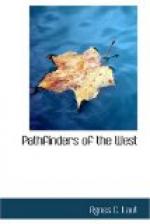The annual boats that came out to Hudson Bay in the summer of 1769 anchored on the offing, six miles from the gray walls of Fort Prince of Wales, and roared out a salute of cannon becoming the importance of ships that bore almost revolutionary commissions. The fort cannon on the walls of Churchill River thundered their answer. A pinnace came scudding over the waves from the ships. A gig boat launched out from the fort to welcome the messengers. Where the two met halfway, packets of letters were handed to Moses Norton, governor at Fort Prince of Wales, commanding him to despatch his most intrepid explorers for the discovery of unknown rivers, strange lands, rumored copper mines, and the mythical Northwest Passage that was supposed to lead directly to China.
The fort lay on a spit of sand running out into the bay at the mouth of Churchill River. It was three hundred yards long by three hundred yards wide, with four bastions, in three of which were stores and wells of water. The fourth bastion contained the powder-magazine. The walls were thirty feet wide at the bottom and twenty feet wide at the top, of hammer-dressed stone, mounted with forty great cannon. A commodious stone house, furnished with all the luxuries of the chase, stood in the centre of the courtyard. This was the residence of the governor. Offices, warehouses, barracks, and hunters’ lodges were banked round the inner walls of the fort. The garrison consisted of thirty-nine common soldiers and a few officers. In addition, there hung about the fort the usual habitues of a Northern fur post,—young clerks from England, who had come out for a year’s experience in the wilds; underpaid artisans, striving to mend their fortunes by illicit trade; hunters and coureurs and voyageurs, living like Indians but with a strain of white blood that forever distinguished them from their comrades; stately Indian sachems, stalking about the fort with whiffs of contempt from their long calumets for all this white-man luxury; and a ragamuffin brigade,—squaws, youngsters, and beggars,—who subsisted by picking up food from the waste heap of the fort.




